I have a fetish for all things electronic and technical, and
aquarium-related gadgets are no exception. I first wrote
about aquarium dosing pumps back in 1996 in an article entitled
“Methods for Replacing Evaporated Water and Dosing
Limewater” (Aquarium Frontiers, Vol.3 No.
4). I revisited the topic in 1998 and again in 2003 as
newer and better products appeared in the aquarium
marketplace. Well, I don’t have any new products to
share this time around but I did want to update everyone on my
experiences with the Spectrapure LiterMeter line of peristaltic
dosing pumps. For those unfamiliar with the term
“peristaltic pump,” this description from the
Cole-Parmer catalog sums it up nicely: “Peristaltic
pumps are also called tubing pumps. They consist of two
parts: a rotor and housing. The tubing is placed between
the rotor and housing where it is occluded (squeezed) by
rollers. After being pinched, the tubing behind and
between the rollers recovers its shape. This creates a
vacuum and draws fluid behind it. A “pocket”
of fluid is then created. The rollers on the rotor
continue to move across the tubing “pushing” this
pocket of fluid. The speed of the rotor and the inside
diameter of the tubing determine the flow rate. As both
increase so does the flow rate.”

This original LiterMeter dosing pump has been in continuous use for over 7 years. The only maintenance that’s been required was to replace the tubing two years ago. It’s pictured here on the side of the author’s 42 gallon hexagon aquarium.
Some of the features and advantages of peristaltic pumps in
general, and the LiterMeter pump in particular,
include:
- It can run dry for an indefinite period of
time. - With some limitation, it can pump a slurry, such as a
milky solution of kalkwasser, without fear of clogging. - It is self-priming, and can lift a fluid from a
reservoir. - The fluid is confined to the tubing and does not contact
the pumping mechanism or the air, which is especially
advantageous when that fluid is a corrosive or caustic one,
such as kalkwasser, which has a pH of approximately
12. - The design of peristaltic pumps precludes the need for
check valves, which are part of many dosing pump systems and
invariably fail. - The rotor mechanism is the only moving part and
it’s maintenance-free. - It’s energy efficient. For example, the
LiterMeter consumes less than 3 watts of electricity in its
running mode! - It’s relatively quiet and can be used in a living
room or bedroom setting.
Having used all the dosing pumps for general sale in the
aquarium marketplace, and many of the hospital-surplus
peristaltic pumps re-sold in the aquarium market, I’ve
concluded that the current Spectrapure LiterMeter III is the
most reliable and best-designed dosing pump available to
aquarists. I suspect that part of the reason is because
it was designed from the ground up to work with aquarium
applications and not adapted for aquarium use.
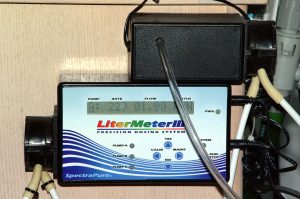
This is a close-up of the newer LiterMeter III dosing system that’s been in use for three years on the author’s 38 gallon reef aquarium. It’s been maintenance and trouble-free during the entire time.
I especially like the fact that it can independently control
up to three pump heads. This makes it ideal for dosing
two-part calcium/alkalinity supplements or doing automatic
water changes. The LiterMeter III offers an option that
will turn the pump off when the water level in the sump or
aquarium reaches a pre-determined level. Even though the
total daily output is fixed once it has been set, this is an
important safeguard and eliminates the need to fine-tune the
output continually.
The latest LiterMeter III can be set to dose as little as 50
milliliters to as much as 100 liters (~25 gallons) over a 24
hour period. It’s capable of lifting liquids 25
feet and pumping to a height of 60 feet! Calibrating the
pump is very simple too: Press the calibration button to
start the pump; press it again after measuring 500 ml of
effluent. Once each pump is calibrated, all you have to
do is set the total amount you want to dose each
day.

The LiterMeter III with optional second dosing pump is used to dose a two-part calcium/alkalinity supplement into the author’s 38 gallon reef setup. It’s proven to be very accurate and reliable in three years of use. The 2.5 gallon twin reservoirs are refilled weekly.
The only maintenance is to periodically replace a small
piece of tubing. I’ve replaced the tubing once in
seven years of use on the original LiterMeter, and I’ve
yet to replace it after three years of continuously using the
LiterMeter III. I’ve also not experienced any
technical or quality issues with either pump during that
time. That’s outstanding reliability. And
I’ve been told that the latest LiterMeter III utilizes a
new and improved all-aluminum motor drive for enhanced
reliability and quieter performance.
You can find more info on the LiterMeter III dosing system,
including online sources for purchase, at
www.spectrapure.com.
I don’t write about lighting products often because I
don’t have the tools necessary to perform sophisticated
measurements, but there are many factors to consider other than
PAR value when purchasing a light fixture to hang over a reef
aquarium: Aesthetics, value, longevity, efficiency, and
perhaps the most important criteria of all, the growth and
coloration of the living creatures in the aquarium
itself. This last criterion can only be discerned by
hanging the fixture over a living reef aquarium for an extended
period of time and observing the results. When I last
wrote about the IceCap stainless steel pendant that features a
metal halide flood lamp, I had been using it for approximately
12 months. Well it’s now been 24 months with the
same lamp and I remain equally impressed. In fact, my 42
hex aquarium has now become my frag grow-out tank because I get
the fastest growth and best coloration of SPS corals in this
aquarium.

Pictured is a fragment of a purple colored Acropora millepora in the author’s 42 gallon hexagon aquarium shortly after installing the IceCap pendant.

Pictured is the same purple Acropora millepora now grown to a full-sized colony two years later in the author’s 42 hex aquarium.

This is a picture of the author’s 42 hex reef aquarium shortly after installing the IceCap pendant fixture.
As a recap from my previous review, the pendant housing is
constructed of heavy brushed stainless steel. It’s
infinitely adjustable vertically by pulling and pushing on the
steel hanging wires. The fixture has held up well in 24
months of use. Any discoloration of the steel is easily
brushed away and the powder-coated parts show no evidence of
peeling or corrosion. As I explained in my previous
review, the fixture itself simply functions as a housing for
the bulb, which is the real story here. Iwasaki managed
to squeeze a 150 watt double-ended metal-halide bulb into a
PAR36 flood lamp. Furthermore, the reflector is built
into the lamp! It’s a very efficient design as all
the light is directed straight down and there’s no loss
of light outside the aquarium. When combined with the
IceCap 150 watt electronic ballast, it makes a highly effective
and efficient combination that rivals most 250 watt setups in
terms of light output.
This is demonstrated in the plots of PAR values at a
distance of 9 inches that Sanjay Joshi was kind enough to
contribute:
These new Iwasaki metal halide flood lamps come in 70 and
150 watt versions, blue and daylight (6500K) color
temperatures, and PAR36 and PAR38 configurations. After
experimenting with the various bulbs, I’ve concluded that
the 150 watt 6500K PAR36 flood lamp (M150P36FD/MED-R 6500K 150W
Flood) is the best design for use over a reef aquarium.
The Iwasaki literature states that the color temperature of
this lamp is 6500K and the CRI is 96. It appears bright
white over the aquarium and doesn’t require supplemental
lighting, unless you’re a blue freak. I’ve
been told that a 10K version of the lamp is being developed,
and I’m looking forward to that.

The same 42 hex reef aquarium at a later date shows great color and growth of the SPS corals with the IceCap pendant and Iwasaki lamp.

This is a current view of the IceCap pendant over the author’s 42 gallon hexagon aquarium after two years of use.
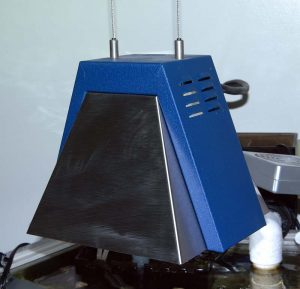
The IceCap pendant is constructed of heavy brushed stainless steel and powder-coated blue paint. It’s vertically adjustable by a simple pull and push of the steel hanging wires.
I should add that the IceCap150 watt electronic ballast
that’s powering this lamp is now 3 years old. It
continues to perform very well and I would never go back to the
standard magnetic core and coil ballast of yore.
I’m able to mount this tiny (fits in the palm of your
hand) IceCap ballast inside my aquarium stand with no concern
for noise or heat. It’s a major improvement over
the cinder-block sized ballast that I used previously.
That one got hot enough to fry an egg!
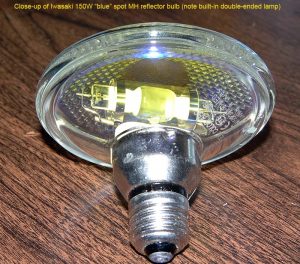
This picture of an Iwasaki metal halide flood lamp clearly shows the built-in 150 watt double ended bulb.

The IceCap 150 watt electronic ballast that drives the pendant fixture is small, lightweight and runs cool, which enables the author to mount it inside the aquarium stand.
You can find out more about the 150 watt lamps and
electronic ballasts at the IceCap website at
http://icecapinc.com. The
fixtures and lamps are on sale through Drs. Foster and Smith at
www.drsfosterandsmith.com.


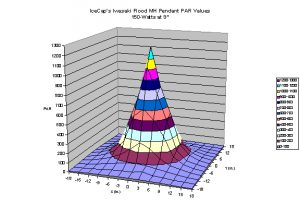
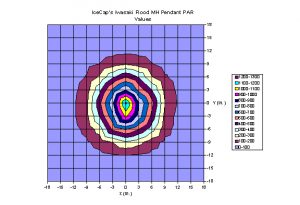

0 Comments